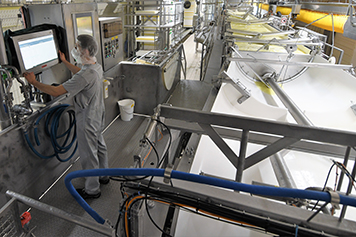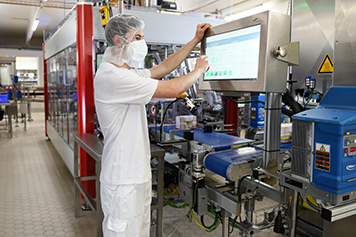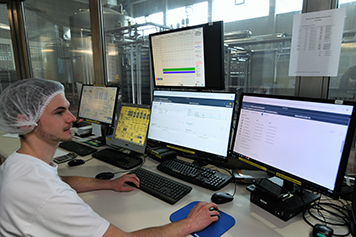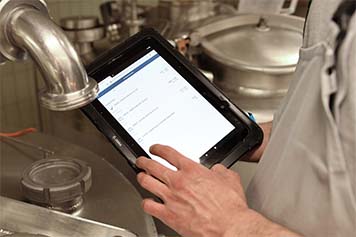Cheese making 4.0
MES facilitates consistent batch traceability
![[Translate to English:] Käseherstellung bei Käserei Champignon | IGZ [Translate to English:] Käseherstellung bei Käserei Champignon | IGZ](/fileadmin/user_upload/Aktuelles/News/2021/KC/igz-news-kc-head.jpg)
The creation of consistent batch traceability was the primary objective and one of the great challenges with respect to the introduction of SAP MII (SAP Manufacturing Integration and Intelligence) at the Champignon Hofmeister business group. The standard software now ensures complete transparency across locations – from the farm to the packaged cheese – and optimises the entire milk processing value chain thanks to digitalisation.
Cheese connoisseurs and gourmets have held the brands in the Champignon Hofmeister business group in high esteem for over 100 years. These include classics like Champignon Camembert, Rougette Ofenkäse (oven cheese), St. Mang Limburger, Cambozola and many more. In total, around 50 types of soft cheese are sold in over 55 countries. They average 520 million euros in sales per year. There are around 1,000 employees behind this achievement, who work for the business group at its headquarters in Lauben, Oberallgäu in Bavaria, as well as at sites in Kammlach, Moosburg, Pfeffenhausen and Freiberg.
Focus on digital process optimisation and documentation
Around 450 million litres of milk are processed by specialists from the Champignon Hofmeister business group each year to produce various speciality cheeses, high-quality milk and whey derivatives. This process is extremely complex: it begins with collections across the country and continues with the acceptance of the milk and its transportation to the business premises. This is followed by the production process in the dairy, maturing, packaging and preparation for dispatch. Before the introduction of SAP Manufacturing Integration and Intelligence (SAP MII), the IT landscape that had developed over the years was characterised by numerous stand-alone solutions that were difficult to maintain and no longer sustainable. Once the decision was made to switch over to the new SAP ERP generation S/4HANA, it was also decided that these old proprietary systems would be replaced. On the level of production data acquisition (PDA), this was essential, as only a few employees had the skills required to operate the PIMS (production information management system), and it was not possible to connect the existing MS Access solution to the new S/4HANA business suite.
Consumption posting – online instead of retrograde

Against this backdrop, a consistent and standardised Manufacturing Execution System (MES) needed to be implemented that would facilitate complete traceability across the entire processing chain from farm to packaging – essentially at just the click of a button. The digitalisation strategy also envisaged abandoning paper-based manual administration, which was time-consuming and prone to errors, and therefore delayed the recording of stock, consumption and production progress.
As opposed to the retrograde approach, a batch-managed consumption posting system was to be realised in real time, and consistent figures (KPIs) were to be generated for all sites. The decision to use the web-based, standardised, highly flexible and future-oriented IT platform SAP MII for production management was also consistent with investment protection factors. After all, through SAP it is possible to guarantee release compatibility and continual standard software updates. The Champignon Hofmeister business group is participating in this rigorous development, maintaining its independence from other individual providers and is in the convenient position of continually expanding its SAP knowledge.
Preconfigured best practices as a project accelerator

As the team at the Champignon Hofmeister business group had already successfully implemented smaller IoT projects based around SAP MII with SAP engineers from IGZ, based in Falkenberg in Eastern Bavaria, the project partnership was resumed in 2019 on the MES level. “Our previous experiences, along with IGZ’s proven expertise in the development of comprehensive solutions in the processing industry, including facility integration and machine connection, were critical factors in this decision,” says Martin Dodel, Project Manager. “In addition, the sophisticated project methodology and IGZ best practices were also appealing as project accelerators.”
IGZ best practices Fill+Pack and Flow+Pack
After the completion of the SAP MII deployment analysis, the implementation of the SAP MII system was launched at the end of July in the same year. The great challenge posed by this was trying to consistently embed the SAP MII migration concept into the parallel S/4HANA project. In Phase 1, basic functions were integrated at the Kammlach site. To do this, a template for a consistent and standardised SAP MII solution was developed to map all of the core processes at every production facility of the traditional cheese dairy. The preconfigured IGZ best practices Fill+Pack for automated packaging lines and Flow+Pack for the operating room and the cheese dairy were also integrated into this group template. This shortened the implementation period considerably.
Paperless order processing and seamless documentation

During implementation at the pilot site in Kammlach, the integration of SAP MII into SAP S/4HANA was carried out in the form of process orders based on a control recipe. This ensured consistent online order processing. Through its connection to the SAP Extended Warehouse Management (SAP EWM) system, packaging materials were also able to be mapped in the MES, as well as raw goods and finished products. The connection to the relevant production control systems for the provision of each recipe ensured complete traceability for each individual batch. In turn, the primary focus of the SAP EWM system is supply and waste disposal for the production process. Stock, batches and tasks are reported online and can therefore be tracked at any time.
Employees benefit from clear data on things like the progress of the maturing process that can be accessed through mobile user interfaces in the modern SAP UI5 design. This makes it possible to trace which action was carried out by which person at which workplace at any time. Consistent traceability is rounded off through the connection of two automated packaging lines that are each equipped with five units and a manual work station. SAP MII controls the packaging process in full and automatically documents consumption and production quantities down to the individual batch using online production and machine data acquisition. In addition, SAP MII takes over pallet labelling and informs the SAP EWM system when pallets are complete and therefore communicates stock levels as well.
"Through the introduction of SAP MII, we are able to map the entire internal production chain."
Martin Dodel, Project Manager at Käserei Champignon
Process security in production

Even if the SAP ERP system is temporarily unavailable, processes continue to run uninterrupted. Data collection occurs in real time and removes the need for subsequent manual documentation. This systematic prevention of sources of errors and disruptive factors in connection with an integrated process interlocking and control system makes a critical contribution to maintaining high-quality and efficient processes – or even further improving them. This eliminates the risk of the wrong ingredients or components being used and ensures that all types of cheese can be processed correctly without exceptions. System-supported traceability ensures transparency across all stock, raw goods, goods being processed and finished products. Even the regular cleaning processes necessary in the maturing rooms are now documented digitally. In addition, the standardised MES system based on SAP MII facilitates batch-managed consumption posting in real time, from the raw milk tank to dispatch. This will extend across all sites in the Champignon Hofmeister business group in the future.
Multiple IT projects designed and implemented in parallel
The go-live in Kammlach took place as planned on the same date as the switch to S/4HANA at the turn of the year 2020/2021. The initial requirements to meet the precise schedule had already been established as part of the general IT concept. After all, there was not just one project to implement: SAP Dairy was developed, new technologies (like RFID for the automatic identification of types of cheese) were implemented, and the SAP S/4HANA, SAP EWM, SAP MII and production control systems were introduced. In this context, Martin Dodel highlights the flexible and professional support provided by IGZ: “For such a complex project, companies need a strong partner, which we had with IGZ by our side. The great wealth of experience and high level of process and integration expertise were important factors in the successful implementation of the MES project.”
Optimisation-focussed functional enhancements and roll-outs
In Kammlach, complete end-to-end traceability as the basis for reliable and data-supported order processing as part of digitised production is already a reality. On the basis of the SAP MII template, site-specific functional enhancements and optimisations will be implemented in Phase 2, such as the additional integration of further production control systems, substantial in-process quality controls, the recording of the operating conditions of all units and cross-departmental OEE capturing. With Extended OEE 4.0, an IGZ best practice also comes into play that continually calculates and optimises the efficiency or performance level of an entire facility (OEE = Overall Equipment Effectiveness) using key indicators.
The template, designed as part of the pilot project in Kammlach, will be gradually expanded and supports the rollout to further facilities and processes there for the Champignon Hofmeister business group. This significantly reduces the workload for implementing SAP MII. The go-live for Phase 2 (“Mang+”) is therefore already planned for the end of 2021, and then further production facilities should follow gradually until 2024. Martin Dodel’s team is well equipped for the rollout of SAP MII in the context of the group-wide SAP S/4HANA strategy and can rely on IGZ’s expertise as well. “Through the introduction of SAP MII, we now have the opportunity to map the complete internal production chain digitally and provide a high level of operational support to our production employees,” says the IT expert in summary. “I would be delighted to carry out a project like this with IGZ again at any time.”
Back to overview

